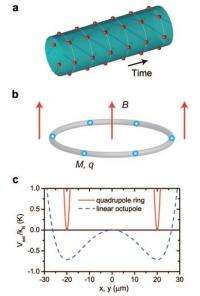July 9, 2012 report
Physics team proposes a way to create an actual space-time crystal

(Phys.org) -- Earlier this year, theoretical physicists Frank Wilczek, of MIT put forth an idea that intrigued the research community. He suggested that it should be possible to construct a so called space-time crystal by adding a fourth dimension, movement in time, to the structure of a crystal, causing it to become an infinitely running clock of sorts. At the time, Wilczek acknowledged that his ideas on how to do so were inelegant, to say the least. Now another international team led by Tongcang Li has proposed a way to achieve what Wilczek proposed using a far more elegant process. They have posted a paper on the preprint server arXiv describing what they believe is a real-world process for creating an actual space-time crystal that could conceivably be carried out in just the next few years.
Wilczek thought that it should be possible to construct a space-time crystal because crystals naturally align themselves at low temperatures and because superconductors also operate at very low temperatures; it seemed reasonable to assume that the atoms in such a crystal could conceivably move or rotate and then return to their natural state naturally, continually, as crystals are wont to do as they seek a lowest energy state. He envisioned a rotation with a ring of ions that flowed separately rather than as a stream, likening it to a mouse running around inside of a snake laying as a circle. The bulge would flow, rather than the snake itself spinning and would just keep on going, potentially forever. The problem was, he couldn’t figure out how such a crystal structure could be created in the real world.
Taking Wilczek’s original idea, but not his method for creating a real world example, Li et al, suggest that to create a space-time crystal all that’s needed is a better ion trap. They believe that if ions could be forced using such a trap, into a ring at very low temperatures, as a superconductor, all that would be needed would be a little nudge from a tiny bit of a magnetic field to cause the ions to begin rotating as a single ring. Because there would be no resistance, and because of their natural mutual repulsion, the ring should then continue rotating indefinitely with no additional injection of energy, resulting in the space-time crystal that Wilczek imagined.
The team is quick to point out, for those that might be making the jump, that the result would not be the mythical perpetual motion machine because no energy could be extracted from the space-time crystal. They do believe that building an actual space-time crystal should be possible though, in the near term if a future team has the funds necessary to overcome the difficulty of creating a better ion trap.
More information: Space-time crystals of trapped ions, arXiv:1206.4772v1 [quant-ph] arxiv.org/abs/1206.4772
Abstract
Great progresses have been made in exploring exciting physics of low dimensional materials in last few decades. Important examples include the discovering and synthesizing of fullerenes (zero dimensional, 0D), carbon nanotubes (1D) and graphene (2D). A fundamental question is whether we can create materials with dimensions higher than that of conventional 3D crystals, for example, a 4D crystal that has periodic structures in both space and time. Here we propose a space-time crystal of trapped ions and a method to realize it experimentally by confining ions in a ring-shaped trapping potential with a static magnetic field. The ions spontaneously form a spatial ring crystal due to Coulomb repulsion. This ion crystal can rotate persistently at the lowest quantum energy state in magnetic fields with fractional fluxes. The persistent rotation of trapped ions produces the temporal order, leading to the formation of a space-time crystal. We show that these space-time crystals are robust for direct experimental observation. The proposed space-time crystals of trapped ions provide a new dimension for exploring many-body physics and emerging properties of matter.
Journal information: arXiv
© 2012 Phys.org



















